Bennemann K.H., Ketterson J.B. Superconductivity: Volume 1: Conventional and Unconventional Superconductors; Volume 2: Novel Superconductors
Подождите немного. Документ загружается.


17 Photoemission in the High-T
c
Superconductors 959
Fig. 17.30. Symmetrized spectra corresponding to the raw
spectra (a), (b,(c) of Fig. 17.28. The gap closing in the raw
spectrum of Fig.17.28 corresponds to when the pseudogap
depression disappears in the symmetrized spectrum.Note
the appearance of a spectral peak at higher temperatures
in (c)
to be valid.We have extensively checked this method,
and studied in detail the errors introduced by incor-
rect determination of the chemical potential or of k
F
(which lead to spurious narrow features in the sym-
metrized spectra), and the effect of the small (1
◦
ra-
dius) k-window of the experiment (which was found
to be small).
In Fig. 17.30 we show symmetrized data for the
UD 83 K underdoped sample corresponding to the
raw data of Fig. 17.28. To emphasize that the sym-
metry is put in by hand, we show the ! > 0curve
as a dotted line. At k point a near (, 0) the sharp
quasiparticle peak disappears above T
c
but a strong
pseudogap suppression, on the same scale as the su-
perconducting gap, persists all the way up to 180K
(T
∗
). Moving to panels (b) and (c) in Fig. 17.30 we
again see pseudogap depressions on the scale of the
superconducting gaps at those points, however the
pseudogap fills up at lower temperatures: 120 K at b
and 95 K at c. In panel c, moreover, a spectral peak
at zero energy emerges as T is raised. All of the con-
clusions drawn from the raw data in Fig. 17.28 are
immediately obvious from the simple symmetriza-
tion analysis of Fig. 17.30.
There are many important issues related to these
results that will be taken up in Sect. 17.7.3 where
we describe modeling the electron self-energy in
the pseudogap state. We will discuss there the re-
markable T-dependent lineshape changes and the
T-dependence of the gap itself. Here we simply
note that, without any detailed modeling, the data
[90] clearly show qualitative differences in the T-
dependence at different k-points. Near the (, 0)
point the gap goes away with increasing temperature
with the spectral weight filling-in, butno perceptible
change in the gap scale with T. On the other hand, at
k
F
points halfway to the node,one sees a suppression
of the gap scale with increasing temperature.
We conclude this discussion with a brief mention
of the implications of our results.We believe that the
unusual T-dependence of the pseudogap anisotropy
will be a very important input in reconciling the dif-
ferent crossovers seen in the pseudogap regime by
different probes. The point here is that each experi-
ment is measuring a k-sumweighted with a different
set of k-dependent matrix elements or kinematical
factors (e.g., Fermi velocity). For instance, quantities
which involve the Fermi velocity, like dc resistivity
above T
c
and the penetration depth below T
c
(super-
fluid density), should be sensitive to the region near
the zone diagonal, and would thus be affected by the
behaviorwe see at k point c. Other types of measure-
ments (e.g., specific heat and tunneling) are more
“zone-averaged” and will have significant contribu-
tions from k points a and b as well, thus they should
see a more pronounced pseudogap effect. Interest-
ingly, other data we have indicate that the region
in the Brillouin zone where behavior like k point c
isseenshrinksasthedopingisreduced,andthus
appears to be correlated with the loss of superfluid
density [94]. Further, we speculate that the discon-
nected Fermi arcs should have a profound influence
on magnetotransport given the lack of a continuous
Fermi contour in momentum space.

960 J.C. Campuzano, M.R. Norman, and M. Randeria
Fig. 17.31. (a) Midpoint shifts (dots )andwidths(diamonds) for an UD 83 K sample at a photon energy of 22 eV at 90 K
for a cut shown by the open dots in (b). (b) Fermi surface at 160 K (solid triangles) and minimum gap locus at 90 K (solid
dots). Notice that the two surfaces coincide within error bars. The error bars represent uncertainties of Fermi crossings
as well as possible sample misalignment. The solid curve is a rigid band estimate of the Fermi surface
17.6.4 Evolution of the Fermi Surface with Doping
We now discuss the doping dependence of the nor-
mal state Fermi surface on the underdoped side of
the phase diagram.The first issue to face up to is: can
the Fermi arcs described above be a manifestation
of a Fermi surface with small closed contours cen-
tered about (/2, /2)? Such hole-pockets enclosing
x holes (per planar Cu) are suggested by some the-
ories of lightly doped Mott insulators (for a review,
see [95]) as alternatives to the large Fermi surfaces
containing (1 + x) holes which would be consistent
with the Luttinger counting.
The T-dependence of the arcs is by itself evidence
against their being part of a pocket Fermi surface.
Nevertheless, if there were such small hole pockets
then one should observe two features in the ARPES
data: a closure of the Fermi arc on the other side
of (/2, /2), which would be clear evidence for a
“shadow band”-like dispersion ((, )-foldback of
the main band) in the UD samples. In a variety of
UD samples we have carefully searched for both these
features and found no evidence for either [41]. How-
ever this is a tricky issue, given the very broad spec-
tra and possiblematerials problems in the highly UD
samples. Nevertheless, given the available evidence,
the gapless arcs that we observe [90] are simply an
intermediate state in the smooth evolution of d-wave
nodes into a full Fermi surface. This smooth evolu-
tion was carefully checked on an UD 831 K sample
where a dense mapping was done in k space at T =
90 K, revealing only a small Fermi arc just above T
c
.
The other issue related to the Fermi surface is:
what is its doping dependence above T
∗
where the
pseudogap effects are absent. While one can easily
compare the near optimal and lightly UD Fermi sur-
faces, the rapid rise of T
∗
with underdoping does not
permit us to address this question. However, one can
study the “minimum gap locus” in any gapped state,
in close analogy with the manner in which this was
defined in the SC state; see Sect. 17.5.
There is also a more fundamental reason to study
the “minimum gap locus” in the pseudogap regime.
One wants to know whether the pseudogap is “tied”
to the Fermi surface,or if it has some othercharacter-
istic momentum Q (unrelated to k
f
). In Fig. 17.31(a)
[41] we follow the dispersion of an UD 83K sample
in the pseudogap regime. Moving perpendicular to
the (expected) Fermi surface from occupied to un-
occupied states, one finds that the dispersion first
approaches the chemical potential and then recedes
away from it. This locates a k-point on the mini-
mum gap locus. For a lightly UD sample we find in
Fig.17.31(b) that this locus in the pseudogap regime
coincides, within experimental error bars, with the
Fermi surfacedeterminedabove T
∗
wherethere is no
pseudogap. The pseudogap is thus tied to the Fermi
surface in the same way the SC gap is, and is in con-
trast with, say, charge or spin density waves, which
are tied to other characteristic Q vectors.
In the more heavily underdoped samples, it is not
possible to compare the minimum gap locus in the
pseudogap state with the Fermi surface above T
∗
,or
the minimum gap locus below T
c
, since the latter
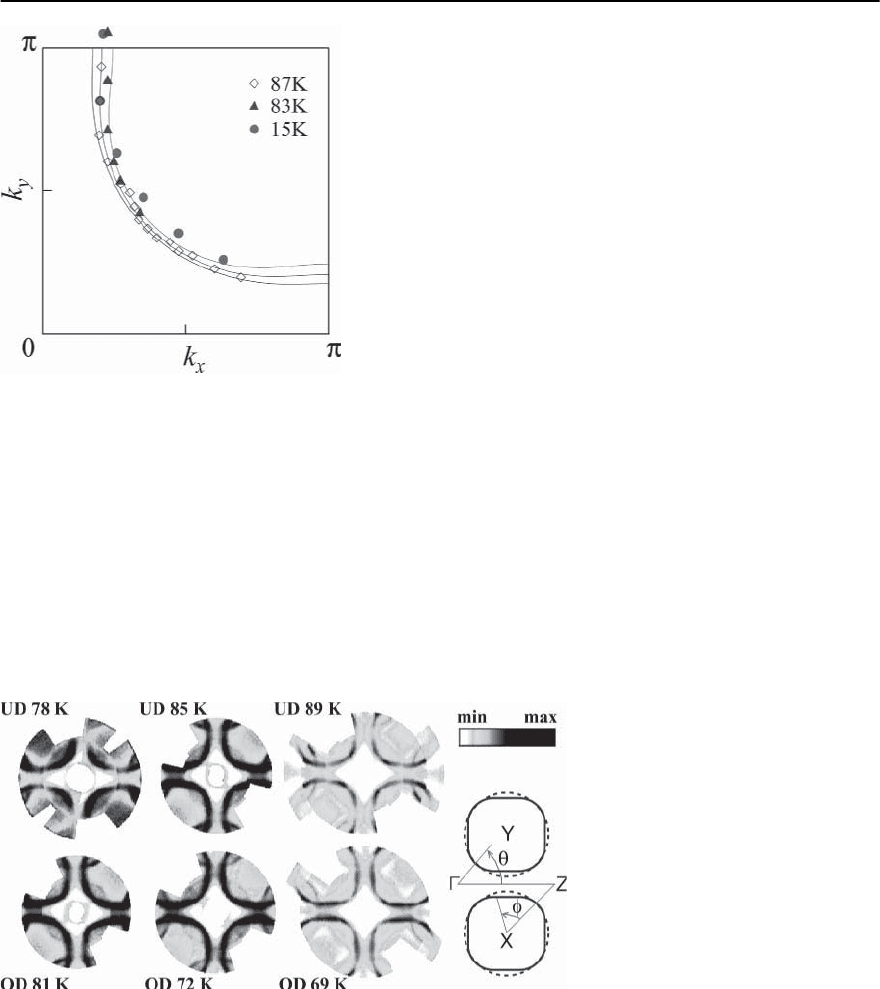
17 Photoemission in the High-T
c
Superconductors 961
Fig. 17.32. Fermi surfaces of the 87 K, 83 K, and 15 K sam-
ples. All surfaces enclose a large area consistent with the
Luttinger count (see text).The solid lines are tight binding
estimates of the Fermi surface at 18%, 13%, and 6% doping
assuming rigid band behavior
two are not measurable with T
∗
too high and T
c
too
low. Nevertheless, if one assumes,by continuity,that
the minimum gap locus in the pseudogap state gives
informationabout the Fermi surface that got gapped
out, then even for an highly UD sample one finds a
large underlying Fermi surface, satisfying the Lut-
tinger count of (1 + x)holesperplanarCu[41]as
shown in Fig. 17.32.
The same conclusion has been recently reached
by the Dresden group [42]. Figure 17.33 reproduces
their Fermi energy intensity maps as a function of
doping, where a large Fermi surface (plus its shadow
band image) is always visible. They argue, though,
that the volume is not quite 1 + x,andtheyattribute
this difference to the presence of bilayer splitting.
17.6.5 Low Energy Versus High Energy Pseudogaps
In all of the preceding discussion we have focussed
on the “low energy” or leading-edge pseudogap. It
is important to point out that the phrase pseudogap
is (somewhat confusingly) also used to describe a
higher energy feature, which we call the “high en-
ergy pseudogap”.
The presence of a high energy pseudogap was ev-
ident in the first ARPES work on the pseudogap,
reproduced in Fig. 17.34 [87]. As the doping is re-
duced from optimal doped,a gap opens up in a region
around the (, 0) points of the zone. The energy of
this gap is significantly higher than the leading edge
gap emphasized in later work [88,89]. The resulting
dispersion of this high energy feature looks reminis-
cent of what is expected for a spin density wave gap.
Fig. 17.33. Basal plane projection of the normal-state (300 K) Fermi surface of Bi(Pb)-2212 from high-resolution ARPES.
The E
F
intensity (normalized to the signal at ! =0.3eV)isshowningrayscale.TheT
c
of each sample is indicated. The
raw data cover half of the gra y-black area of each map and have been rotated by 180
◦
around the point to give a better
k-space overview. The line dividing raw and rotated data runs almost vertically for the UD76 K map and from top left
to bottom right in all other maps. The sketch shows the Fermi surface for the OD69K data set as black barrel-like shapes
defined by joining the maxima of fits to the normalized E
F
MDCs (from [42])
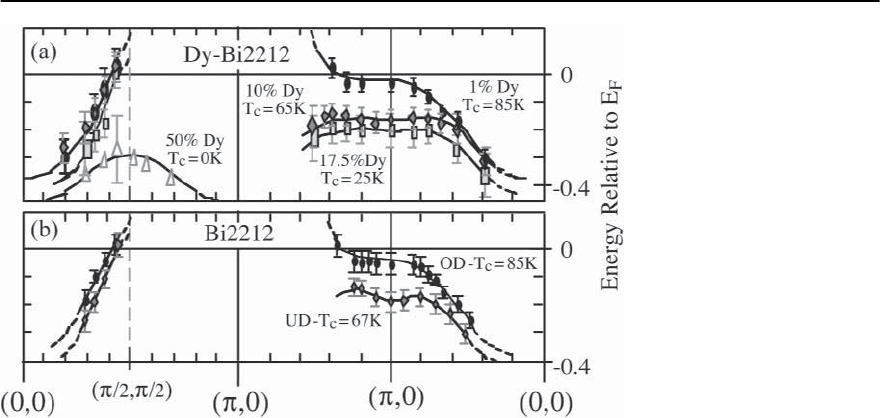
962 J.C. Campuzano, M.R. Norman, and M. Randeria
Fig. 17.34. (a)and(b) Map peak centroids vs k for Bi
2
Sr
2
Ca
1−x
Dy
x
Cu
2
O
8+ı
thin films and deoxygenated Bi
2
Sr
2
CaCu
2
O
8+ı
bulk samples, respectively, with various hole doping levels. (a) Filled oval, 1% Dy near optimal doping with T
c
=85K;
gray diamond, 10% Dy underdoped with T
c
=65K;gray rectangle, 17.5% Dy underdoped with T
c
=25K;triangle,
50% Dy insulator.(b) Filled oval, 600 air annealed slightly overdoped with T
c
=85K;gray diamond, 550 argon annealed
underdoped with T
c
= 67 K (from [87])
As the doping is further reduced, an energy gap then
opens up along the (, ) direction,and the material
becomes truly insulating.
In Fig. 17.35 [59] we show the temperature depen-
dence of the (, 0) spectrum for an UD 89 K sample.
Note that there is no coherent quasiparticle peak un-
til the system is cooled below T
c
,withonlyabroad
incoherent spectrum observed for all T > T
c
.The
leading edge pseudogap which develops below T
∗
is
difficult to see on the energy scale of this figure; the
midpoint shift at 135 K is 3 meV. However, a higher
energy feature can easily be identified by a change
in slope of the spectra as function of binding en-
ergy; this is also very clear in the data of Fig. 17.48
of Sect. 17.6). At the highest temperature T = 247 K
this feature is just due to the Fermi function cut-
off, but in the pseudogap regime, this feature actu-
ally represents the onset of loss of spectral weight
on a high energy scale, and hence may be called the
“high energy pseudogap”. It can also be seen from
Fig. 17.35 that the energy scale of this feature is very
similar to that of the well-known (, 0)-hump of the
peak/dip/hump structure seen in the SC state. This
connection will be discussed in detail in Sect. 17.6
where we also argue that the high energy pseudogap
and the hump have similar dispersions [59].
17.6.6 Origin of the Pseudogap?
We conclude with a summary of ARPES results on
the pseudogap and a brief discussion of its theoreti-
cal understanding.
As described above,the low-energy (leading edge)
pseudogap has the following characteristics.
• The magnitude of the pseudogap near (, 0),i.e.,
the scale of which there is suppression of low en-
ergy spectral weight above T
c
,isthesameasthe
maximum SC gap at low temperatures. Further
both have the same doping dependence.
• There is a crossover temperature scale T
∗
above
which the full Fermi surface of gapless excita-
tions is recovered. The pseudogap near (, 0)
appears below T
∗
.
• The normal state pseudogap evolves smoothly
through T
c
into the SC gap as a function of de-
creasing temperature.
• The pseudogap is strongly anisotropic with k-
dependence which resembles that of the d-wave
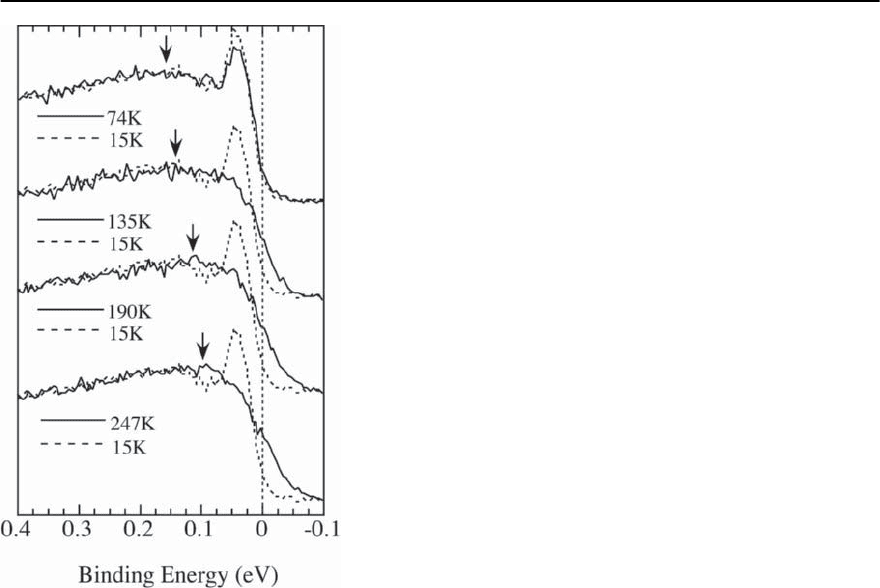
17 Photoemission in the High-T
c
Superconductors 963
Fig. 17.35. Spectra at the ( , 0) point for an UD 89 K sam-
ple at various temperatures compared with the low tem-
perature (15 K) spectrum. The position of the high energy
feature is marked by an arrow
SC gap. The anisotropy of the pseudogap seems
to be T-dependent leading to the formation of
disconnected Fermi arcs below T
∗
.
• The pseudogap is“tied”tothe Fermi surface,i.e.,
the minimumgaplocus in thepseudogapregime
coincides with the Fermi surface above T
∗
and
the minimum gap locus deep in the SC state, at
least in those samples where all three loci can be
measured.
The simplest theoretical explanation of the pseu-
dogap, qualitatively consistent with the ARPES ob-
servations, is that it arises to due pairing fluctua-
tions above T
c
[86, 96]. The SC gap increases with
underdoping while T
c
decreases. Thus in the under-
doped regime T
c
is not controlled by the destruction
of the pairing amplitude,as in conventional BCS the-
ory, but rather by fluctuations of the phase [97] of
the order parameter leading to the Uemura scaling
T
c
∼
s
[94].Eventhough SC order is destroyedatT
c
,
the local pairing amplitude survives above T
c
giving
rise to the pseudogap features.A natural mechanism
for such a pseudogap coming from spin pairing in a
doped Mott insulator exists within the RVB frame-
work [98], with possibility of additional chiral cur-
rent fluctuations [99].
More recently the pairing originof the pseudogap
has been challenged. Some experiments [100] have
been argued to suggest a non-pairing explanation
with a competition between the pseudogap and the
SC gap. A specific realization of this scenario is the
staggered flux or d-densitywave mechanism [101]in
which T
∗
is actually a phase transition below which
both time-reversal and translational invariance are
broken. A more subtle phase transition with only
broken time-reversal has also been proposed [102]
as the origin of the pseudogap.
Although a qualitative understanding of some of
the characteristics of the pseudogap within the non-
pairing scenarios is not clear at this time, these the-
ories make sharp predictions about broken symme-
tries below T
∗
which can be tested. A very recent
ARPES study [103] of circular dichroism finds evi-
dence in favor of broken time reversal, thus casting
some doubt on the pairing fluctuation ideas.The last
word has clearly not been said on this subject, either
theoretically or experimentally, and the origin of the
pseudogap remains one of the most important open
questions in the field of high T
c
superconductors.
17.7 Photoemission Lineshapes and the
Electron Self-Energy
Under certain conditions, which were discussed in
Sect. 17.2, ARPES measures the occupied part of the
single particle spectral function, A(k, !)f (!), with
A = ImG/ where G is the Greens function. The lat-
ter can be expressed as G
−1
= ! −
k
−£(k, !)where
k
is the single-particle energy (defined by the kinetic
energy and single-particle potential energy terms of
the Hamiltonian) and £ is the Dyson self-energy (i.e.,
everything else). Often, this form is associated with
a perturbative expansion used to estimate £,butof

964 J.C. Campuzano, M.R. Norman, and M. Randeria
course the expression is itself tautological. The pur-
pose of writing G in this form is that it isolates all
many-body effects in the function £.Anadvantage
of ARPES is that one has the possibility of extract-
ing £ directly from the data, allowing comparison to
various microscopic predictions for £.
One of the more trivial examples of this is when
one fits ARPES data to determine the supercon-
ducting gap, . For instance, the work described in
Sect. 17.5 [21] used a broadened form of BCS theory
to fit the leading edge of the spectra. This is equiva-
lent to £ =−i +
2
k
/(! +
k
+ i ), =0describing
standard BCS theory. The advantage of this proce-
dure is the actual gap function, , is extracted from
the data, rather than ill defined quantities, such as
the often utilized leading edge shift (midpoint of the
leading edge) which is not the same as because of
lifetime andresolutioneffects.Whenthisisdone,a
k
is obtained which has rather spectacular agreement
with that expected for a d-wave order parameter. Al-
though ARPES contains no phase informationof the
order parameter, the linear behavior of
k
along the
Fermi surface near the gap zero (node) implies a sign
change. Moreover, ARPES has the additional advan-
tage of determining the shape of
k
in the Brillouin
zone,which gives important informationon the spa-
tial range of the pairing interaction [79], as also dis-
cussed in Sect. 17.5.
Evenwhen fitting dataat low temperatures includ-
ing energy and momentum resolution, a non-zero
is always needed. The origin of this residual is
still debated. It is larger than what is expected based
on impurityscattering,and certainly larger than that
impliedbyvarious conductivity probes(thermal,mi-
crowave, and infrared). Although the transport scat-
tering rate is different from Im£ (and in particular,
only Umklapp processes contributeto electrical con-
ductivity), the discrepancy is still large enough to be
noticeable, even when taking into account the fact
that in the simple approximation being employed
here, represents some average of Im£ over a fre-
quency range of order .
Although it has been suggested that the residual
is due to surface inhomogeneity effects (in partic-
ular, a distribution of due to local oxygen inho-
mogeneities [104]), a more likely possibility is that
it is the same effect which is seen in normal metals
like TiTe
2
. In the latter case, it was convincingly ar-
gued that this was the expected final state lifetime
contamination effect when attempting to extract £
from ARPES spectra [105].Although the latter is ex-
pected to vanish in the pure 2D limit, even small 3D
effects can lead to a noticeableeffect,sincefinal state
lifetimes are large. For instance,in simple models,its
contribution to is of order (v
i
c
/v
f
c
)
f
,wherev
i
c
is
the c-axis velocity of the initial state, v
f
c
that of the
final state, and
f
is the final state lifetime [18].Since
f
is typically of order 1 eV, then a velocity ratio of
only 0.01 is sufficient to cause a residual of 10 meV.
With this as an introduction, in this section, we
desire to take a more serious look at the issue of
extracting £ from the data.The most commonly em-
ployed strategy is to come up with some model for
£, and then see how well it fits the data, as illustrated
by the simple example above. We will discuss this
approach in more detail later. We start, though, with
discussing an alternate approach which we have re-
cently advocated.
17.7.1 Self-Energy Extraction
Let us first assume we know A.Giventhat,wecan
easily obtain £. A Kramers–Kronig transform of A
will give us the real part of G
ReG(!)=P
+∞
−∞
d!
A(!
)
!
− !
, (17.13)
where P denotes the principal part of the integral.
Knowing now both ImG and ReG,then£ can be di-
rectly read off from the definition of G.
Im£ =
ImG
(ReG)
2
+(ImG)
2
Re£ = ! − −
ReG
(ReG)
2
+(ImG)
2
. (17.14)
To obtain ReG usingEq.(17.13),weneed toknowA
for all energies. From ARPES, though, we only know
the product of A and f . (While unoccupied states
can be studied by inverse photoemission, its reso-
lution at present is too poor to be useful for our
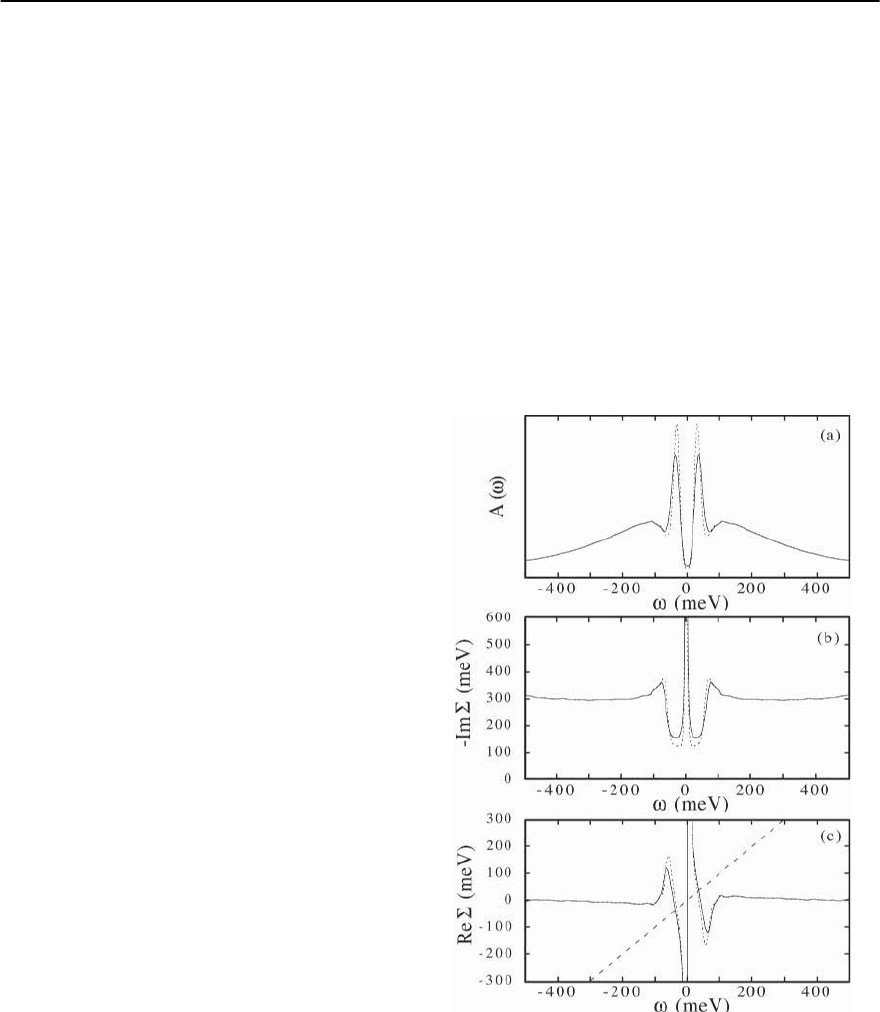
17 Photoemission in the High-T
c
Superconductors 965
purposes.) This is not a limitation if an occupied
k-state is being analyzed and one can either ignore
the unoccupied weight or use a simple extrapolation
for it (except that only Re£ + is determined).On the
other hand,one is usually interested in k vectors near
the Fermi surface. Therefore a key assumption will
have to be made. We can implement our procedure if
we make the assumption of particle–hole symmetry,
A(
k
, !)=A(−
k
, −!), within the small k-window
centered at k
F
.Then,A is obtained by exploiting
the identity A(
k
, !)f (!)+A(−
k
, −!)f (−!)=
A(
k
, !), which holds even in the presence of the
energy resolution convolution. Note, this can only be
invoked at k
F
, and was used previously to remove
the Fermi function from ARPES data [90], where it
was denoted as the symmetrization procedure (note
that the “symmetrized” data will correspond to the
rawdatafor! <∼ −2.2kT). Although the particle–
hole symmetry assumption is reasonable for small
|!| where it can be tested in the normal state by
seeing whether the “symmetrized” spectrum has a
maximum at the Fermi energy (E
F
), it will almost
certainly fail for sufficiently large ! > 0. Neverthe-
less, since we only expect to derive £ for ! < 0, then
the unoccupied spectral weight will affect the result
only in two ways. The first is through the sum rule
d!A(!) = 1 which must be used to eliminate the
intensity prefactor of theARPES photocurrent.From
Eq. (17.14), we see that violation of the sum rule will
simply rescale Im£, but not Re£ due to the ! −
factor. Our normalization, though, is equivalent to
assuming n
k
F
=0.5,andthusdoesnotinvolve“sym-
metrized” data. The second influence comes from
the Kramers–Kronig transformation in Eq. (17.13),
which is a bigger problem.Fortunately, the contribu-
tion from large !
> 0, for which our assumption is
least valid, is suppressed by 1/(!
− !). Further, for
k
F
,
k
=0 and thus Re£ is not plagued by an unknown
constant.
When using real data, it is sometimes desirable
to filter the noise out of the data, as well as to de-
convolve the energy resolution,beforeemploying the
above procedure.These details canbe foundin [106].
Moreover, it is assumed that any “background” con-
tribution (see Sect. 17.2) has been subtracted from
the data as well.
In Fig. 17.36a, we show T = 14 K symmetrized
data for a T
c
= 87 K Bi2212 overdoped sample at
the (, 0) point [106]. We note the important differ-
ences in this superconducting state spectrum, com-
pared with the normal state one (which can be fit by
a simple Lorentzian), due to the opening of the su-
perconducting gap, with the appearance of a sharp
quasiparticle peak displaced from E
F
by the super-
conducting gap, followed by a spectral dip, then by a
“hump”at higher binding energies.The resulting £ is
shown in Fig.s 17.36(b) and (c). At high binding en-
ergies, one obtains a constant Im£ with a very large
value (∼ 300 meV). Near the spectral dip, Im£ has a
small peak followed by a sharp drop.
Fig. 17.36.(a)SymmetrizedspectrumforoverdopedBi2212
(T
c
=87K)atT =14Kat( , 0) with (dotted line)and
without (solid line) energy resolution deconvolution. The
resulting Im£ and Re£ areshownin(b)and(c).The dashed
line in (c) determines the condition Re£ = !
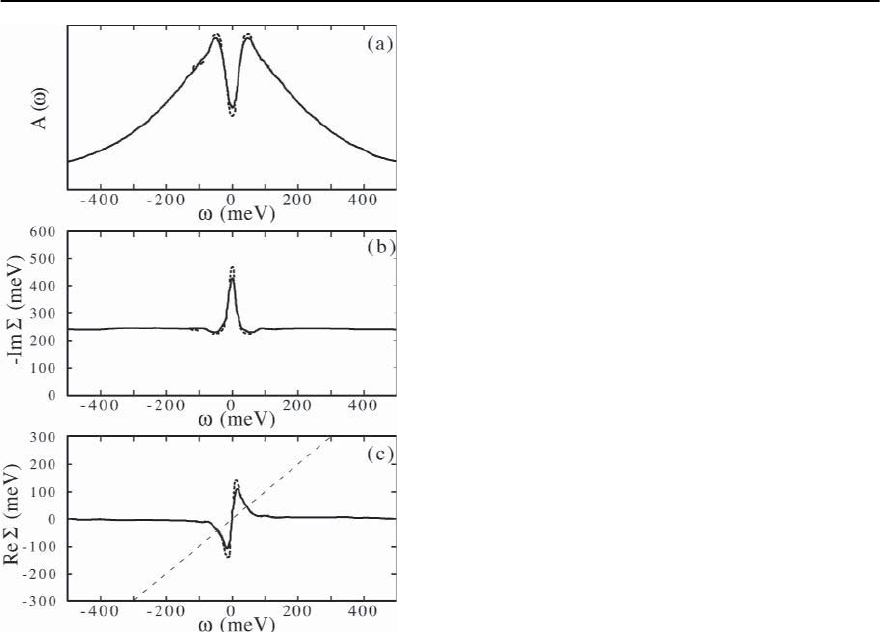
966 J.C. Campuzano, M.R. Norman, and M. Randeria
Fig. 17.37. (a) Symmetrized spectrum for underdoped
Bi2212 (T
c
=85K)atT = 95 K (pseudogap phase) at
the (, 0) − (, ) Fermi crossing with (dotted line)and
without (solid line) energy resolution deconvolution. The
resulting Im£ and Re£ areshownin(b)and(c).The dashed
line in (c) determines the condition Re£ = !
Despite this sharp drop below 70 meV, Im£ re-
mains quite large at low frequencies. Then, below
20 meV, there is a narrow spike in Im£.Thisisthe
imaginary part of the BCS self-energy,
2
/(! + i0
+
),
which kills the normal state pole at ! =0.There-
sulting 1/! divergence of the real part Re£,which
creates new poles at ±=32meV, is easily seen in
Fig. 17.36(c). Thisis followed by a strong peak in Re£
near the spectral dip energy, which follows from the
Kramers–Kronig transformation of the sharp drop
in Im£. The strong peak in Re£ explains why the
low energy peak in A is so narrow despite the large
value of Im£. The halfwidth of the spectral peak is
given by = zIm£ where z
−1
=1−∂Re£/∂! (z is
the quasiparticle residue).In the vicinity of the spec-
tral peak,z
−1
is large (∼9),givinga of ∼14 meV.We
note,though,that is still quite sizeable,and thus the
peak is not resolution limited, as discussed above.
We can contrast this result with that obtained
in the pseudogap phase. In Fig. 17.37(a), we show
T = 95 K symmetrized data from a T
c
=85Kun-
derdoped Bi2212 sample at the (, 0)− (, )Fermi
crossing. One again sees (Fig. 17.37b) a peak in Im£
at !=0, but it is broadened relative to that of the
superconducting state,and the corresponding diver-
gence of Re£ (Fig. 17.37(c)) is smeared out.Such be-
havior would be consistent with replacing the BCS
self-energy
2
/(! + i0
+
)by
2
/(! + i
0
), and can be
motivated by considering the presence of pair fluc-
tuations above T
c
, as will be discussed further be-
low. Note from Fig. 17.37 that although the equation
!−Re£(!) = 0 is still satisfied at |!|∼, zIm£ is
so large that the spectral peak is strongly broadened
in contrast to the sharp peak seen below T
c
.Actually,
to a good approximation,the spectral function is es-
sentially the inverse of Im£ in the range |!| <∼ 2.
We can also contrast this case with data taken above
T
∗
, the temperature at which the pseudogap “disap-
pears”. In that case, the spectrum is featureless, and
the peak in Im£ is strongly broadened.As the doping
increases, this peak in Im£ disappears. Further dop-
ing causes a depression in Im£ to develop around
! = 0, indicating a crossover to more Fermi liquid
like behavior.
17.7.2 Temperature Dependence of Self-Energy
We now turn to the rather controversial issue of
how the spectrum at (, 0) varies as a function of
temperature, that is, how one interpolates between
Figs. 17.36 and 17.37.
In Fig. 17.38, we show data taken for an optimal
doped (T
c
=90K) Bi2212 sample [107]. The leading
edge of the spectral peak is determined by the su-
perconducting gap, whose energy stays fairly fixed
in temperature, and persists above T
c
(the pseudo-
gap). On the trailing edge, one sees a spectral dip,
whose energy also remains fixed in temperature,and
becomes filled in above T
c
due to broadening of the
trailing edge of the peak.
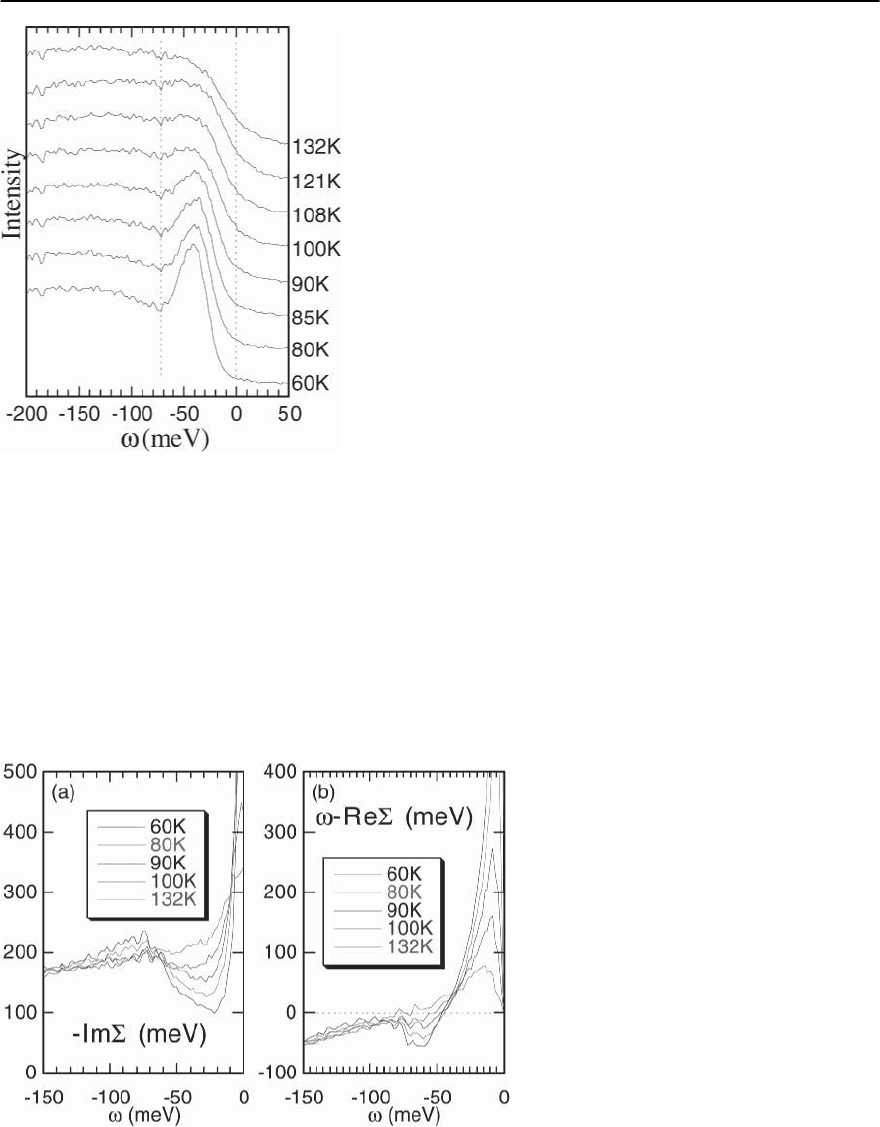
17 Photoemission in the High-T
c
Superconductors 967
Fig. 17.38.Temperaturedependence of ARPESdata at( , 0)
for a T
c
= 90 K Bi2212 sample. The vertical dotted lines
mark the spectral dip energy and the chemical potential
In Fig.17.39(a),Im£ is plotted for various temper-
atures. At low temperatures and energies, it is again
characterized by a peak centered at zero energy due
to the superconducting energy gap, and a “normal”
part which can be treated as a constant plus an !
2
term. A maximum in Im£ occurs near the energy of
the spectral dip. Beyond this, Im£ has a large, nearly
frequency independent, value. As the temperature is
raised, the zero energy peak broadens, the constant
term increases, and the !
2
term goes away.
In Fig. 17.39(b), the quantity !−Re£ is plotted.At
low temperatures and energies, there is a 1/! term
due to the energy gap, and a “normal” part which is
linear in !.As expected, the zero crossing is near the
location of the spectral peak. Beyond this, there is a
minimum near the spectral dip energy, then the data
are approximately linear again, but with a smaller
slope than near the zero crossing. As the tempera-
ture is raised, the gap (1/!) term broadens out and
the low energy linear in ! term decreases,paralleling
the behavior discussed above for Im£.
From Figs. 17.38 and 17.39, we see that rather
than the spectral peak decreasing in weight with in-
creasing temperature, it disappears by broadening
strongly in energy. This can be seen directly by in-
specting Fig. 17.39, in that as the temperature in-
creases, Im£ (Fig.17.39(a)) in the vicinity of the peak
increases in magnitude with T,andz
−1
(roughly the
slope in Fig. 17.39(b) near the zero crossing) de-
creases with T. In fact, it is the strong T variation
of Im£ and z
−1
, and the fact that they operate in con-
cert, which is responsible for the rapid variation in
the effective width of the spectral peak with T.
The above analysis is important in that it shows
how coherence is lost in the system. It is apparent
from Figs. 17.38 and 17.39 that once a temperature
Fig. 17.39. Temperature dependence of (a)Im£
and (b)Re£ derived from the data of Fig. 17.38

968 J.C. Campuzano, M.R. Norman, and M. Randeria
is reached where the spectral peak is no longer dis-
cernable in the data, the difference in behavior of
the self-energy between low energies and high en-
ergies is lost. That is, once the spectral dip is filled
in, the low and high energy behaviors have merged,
and the sharp peak and broad hump at low tempera-
ture is simply replaced by a single broad peak (with
a leading edge gap due to the pseudogap). This is
consistent with the spectral peak simply losing its
integrity as the temperature is raised. The analysis
does not support a picture of a well defined quasi-
particle peak whose weight simply disappears upon
heating, as has been suggested by other authors [92].
17.7.3 Modeling the Self-Energy
This behavior can be further quantified by fitting the
self-energy forbinding energies smaller than the dip
energy to that expected for a superfluid Fermi liq-
uid, and exploring the temperature dependence of
the resulting parameters. The reader can find this
analysis in [107]. Rather, we will discuss here a sim-
pler analysis we performed where we contrasted the
temperature dependence of overdoped and under-
doped samples [108].In this case,we chose to look at
data at the (, 0)−(, ) Fermi crossing (antinode).
The dip/hump structure is considerably weaker here
than at the (, 0) point, allowing us to concentrate
on more general aspects of the spectra.
We begin with the overdoped sample, where there
is no strong pseudogap effect. The simplest self-
energy which can describe the low energy data at
all T is
£(k, !)=−i
1
+
2
/[(! + i0
+
)+(k)] . (17.15)
Here
1
is a single-particle scattering rate taken, for
simplicity, to be an !-independent constant. It is ef-
fectively an average of the (actual !-dependent) £
over the frequency range of the fit.(In [107], we gen-
eralized this to a constant plus an !
2
term, and in-
cluded the resulting linear ! contribution to £
).The
second term is the BCS self-energy discussed previ-
ously.
In Fig. 17.40(a), we show symmetrized data for
an overdoped T
c
=82Ksampleattheantinodeto-
gether with the fits obtained as follows [108]. Using
Eq. (17.15), we calculate the spectral function
A(k, !)=
£
(k, !)
(! −
k
− £
(k, !))
2
+ £
(k, !)
2
,
(17.16)
Fig. 17.40. Symmetrized data for (a)aT
c
=82K
overdoped sample and (b)aT
c
=83Kun-
derdoped sample at the (, 0) − (, )Fermi
crossing at five temperatures, compared to the
model fits described in the text
